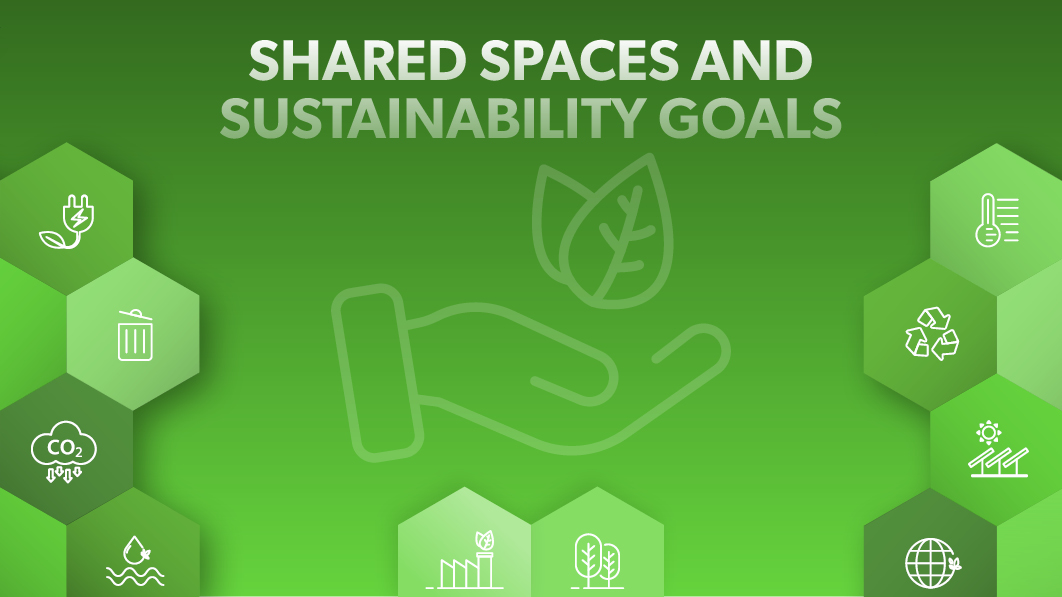
In today’s world, where we place a high value on cleanliness, health, and environmental responsibility, shared spaces have become focal points for sustainable change. But what exactly is a “shared space,” and why has Tennant Company made it a core focus of its sustainability initiatives?
We talked with Adam Litke, Sustainability Innovation Manager, to explore what shared spaces mean to Tennant and how we’re measuring progress in our Shared Spaces initiative. Let’s dive into how we define shared spaces, why they matter, and how Tennant Company is working to make them cleaner, safer, and more sustainable.
What is a shared space?
Shared spaces are where we gather, interact, and live out our daily lives. These are the places where we cross paths with friends, family, colleagues, and neighbors. Think of areas as small as an apartment lobby, hallway or elevator, to your local community center, school, grocery store, or workplace. If you’re meeting people and sharing a common environment, that’s a shared space. They’re the backdrop for our everyday interactions, and they reflect our values of community, health, and safety.
- Shared spaces take many forms, but here are a few specific examples:
- Schools and Universities: where students gather to learn and grow.
- Hospitals and Healthcare Facilities: essential spaces that need the highest standards of cleanliness.
- Workplaces and Offices: where employees connect and create.
- Retail Stores and Grocery Stores: frequented by shoppers daily, requiring high cleanliness for safe shopping.
And there’s an important subset known as “third spaces” — informal gathering places like cafes, parks, libraries, and community centers. These spaces provide a break from work or home, giving people a neutral environment to connect and unwind.
Shared spaces and Tennant Company’s sustainability goals
Tennant Company has made it our mission to help maintain clean, healthy shared spaces. It’s such a core part of our mission that it has its own dedicated impact area within our Thriving People. Healthy Planet. sustainability framework. Tennant Company’s commitment to cleaner, more sustainable shared spaces aligns with our core values of responsibility, innovation, and partnership with the communities we serve.
From a sustainability framework perspective, Tennant Company uses a model that aligns with industry standards and addresses specific areas like energy efficiency, water conservation, social impact, and waste reduction. This model not only guides how we create and improve our products but also helps us evaluate the positive impact our machines have on shared spaces around the world.
Our sustainability goals and the Thriving People. Healthy Planet. framework we use ensure we are creating a meaningful, measurable impact as we pursue our mission.
Why clean shared spaces matter to Tennant Company
Clean and healthy shared spaces are crucial for the well-being of communities. If people don’t feel safe and confident in the cleanliness of shared spaces, it affects community cohesion and trust. Tennant Company plays a unique role here — we don’t just provide cleaning machines; we enable the effective cleaning of these essential areas.
Our products are designed to cover wide space and provide thorough cleaning, helping facility managers achieve and maintain high standards. We’re proud of this role and view it as integral to our mission. That is why we started asking, “How can we measure this impact?” Initially, we considered metrics like the number of spaces cleaned or the machines sold, but we found that the best fit was measuring the total cleaned area in community shared spaces. This metric provides a clear picture of the positive change Tennant Company products are bringing to communities.
Methodology for measuring shared spaces cleaned
To calculate the total area of shared spaces cleaned by Tennant Company products each year, we draw from our extensive product catalog and knowledge of how our machines are used. Each Tennant Company product is designed with specific cleaning capabilities based on its speed, cleaning path, and hours of operation. Depending on the facility type and usage patterns, we can estimate how much area each machine covers annually.
This data also contributes to our annual report on carbon emissions produced by our products during use. With sales data and machine specifications, we’re able to approximate the total amount of space that Tennant Company equipment helps clean each year, providing a clear, tangible metric to measure our impact.
Tracking progress on our 2030 goal: 5,899 trillion square meters cleaned
We’ve set an ambitious target to enable the cleaning of 5,899 trillion square meters of shared spaces by 2030. Progress is tracked annually using sales data and machine specs, with results published yearly to show how we’re advancing. As our machines are deployed worldwide, their collective impact grows, allowing us to make a broader, positive difference.
In last year’s reporting, Tennant Company enabled the cleaning of an area equivalent to the size of California twice over! Picture a fleet of Tennant scrubbers and sweepers moving up and down the entire state — that gives you an idea of the sheer impact we’re making in collaboration with our customers. This commitment shows how Tennant Company’s products are more than machines; they’re essential tools for creating a cleaner, healthier world.
As a leader in sustainable cleaning solutions, Tennant Company is dedicated to making shared spaces safer and healthier for all. Whether in a bustling airport, a neighborhood school, or a local grocery store, our floor care machines are at work supporting community health and environmental sustainability. Through our 2030 goal and ongoing commitment to clean shared spaces, we’re partnering with communities around the world to make a positive, lasting impact – one square meter at a time.
